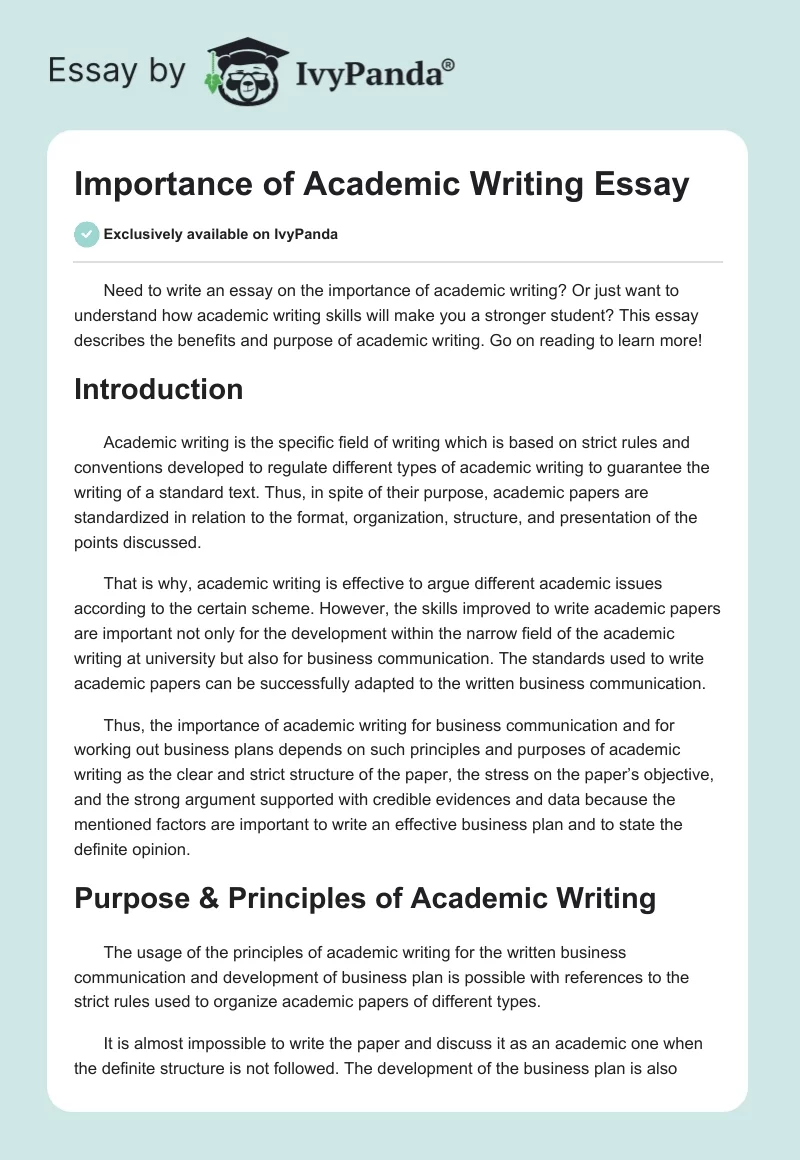Need to write an essay on the importance of academic writing? Or just want to understand how academic writing skills will make you a stronger student? This essay describes the benefits and purpose of academic writing. Go on reading to learn more!
Introduction
Academic writing is the specific field of writing which is based on strict rules and conventions developed to regulate different types of academic writing to guarantee the writing of a standard text. Thus, in spite of their purpose, academic papers are standardized in relation to the format, organization, structure, and presentation of the points discussed.
That is why, academic writing is effective to argue different academic issues according to the certain scheme. However, the skills improved to write academic papers are important not only for the development within the narrow field of the academic writing at university but also for business communication. The standards used to write academic papers can be successfully adapted to the written business communication.
Thus, the importance of academic writing for business communication and for working out business plans depends on such principles and purposes of academic writing as the clear and strict structure of the paper, the stress on the paper’s objective, and the strong argument supported with credible evidences and data because the mentioned factors are important to write an effective business plan and to state the definite opinion.
Purpose & Principles of Academic Writing
The usage of the principles of academic writing for the written business communication and development of business plan is possible with references to the strict rules used to organize academic papers of different types.
It is almost impossible to write the paper and discuss it as an academic one when the definite structure is not followed. The development of the business plan is also based on the clear structure according to which the business plan should present its purpose, the main argument or goal, and the points to be addressed and implemented into practice.
The relevance of the proposed actions should depend on the credible evidences and current data to receive the real picture of the situation and develop the most effective strategy or plan. From this point, the skills used to write the academic paper with the clear structure are also necessary to develop the effective business plan which is easy to be implemented because all the necessary points are mentioned and explained.
Academic papers are written to achieve the definite aim. Thus, the papers are developed to persuade, to argue, to describe, and to contrast and compare facts. There are also a lot of other objectives to write an academic paper (Ballenger, 2010). The ability to stress on the definite objective and complete it in writing is important to developing business papers such as business plans.
As a result, the writing can be discussed as academic when the definite academic goals are achieved with the help of developing different types of papers. To provide the effective written work, it is important to think and act as an academician. It is necessary to read the appropriate books, to discuss the important issues, and to explore the significant information in order to achieve the goal of writing this or that text (Elbow, 1995, p. 72).
From this perspective, to write as a businessman means to write as a person who intends to achieve the definite goal with providing the perfectly structured text which is developed to complete the certain objective. For instance, the main objective of developing a business plan is to provide the effective plan of actions which is designed to overcome the definite issue or propose some strategies.
The academic paper is discussed as strong when it is based on the clear and well-developed argument which is supported by credible evidences. In business communication, it is always important to pay attention to the audience. Thus, the audience of academic writing is often the persons who can have the greater knowledge of the field than the author of the text (Elbow, 1995, p. 81).
That is why, the task of the writer is to provide the effective argument which is carefully developed and supported with reliable facts and evidences to persuade the audience in the writer’s competence in relation to the topic discussed (Hoffman & Ford, 2009). Referring to the example of the business plan, it is possible to note that the successfully structured business plan cannot be discussed as effective, if it is not based on convincing evidences and current data.
The opponents of this idea can state that business writing is correlated with the academic writing only formally. However, persons who are involved in the realities of the business world agree that it is the task of the businessman and writer to operate the information efficiently and organize the paper which meets requirements of the business communication (Ann & David, personal communication, 2013). The skills and principles used in academic writing are important to complete these tasks.
Conclusion
Businessmen should know what to say to the public. If the statement is presented in the written form, it should be organized and formatted more properly than the oral speech.
That is why, the principles of academic writing are helpful to develop business plans, reports, and observations in order to present the material in an effective manner to achieve the definite goal. The written communication is one of the key aspects of business professions that is why the basic principles of academic writing can affect the person’s success in business writing.
References
Ballenger, B. (2010). The curious writer. USA: Longman.
Elbow, P. (1995). Being a writer vs. being an academic: A conflict in goals. College Composition and Communication, 46(1), 72-83.
Hoffman, M. & Ford, D. (2009). Organization rhetoric: Situation and strategies. California: SAGE Publishers.


